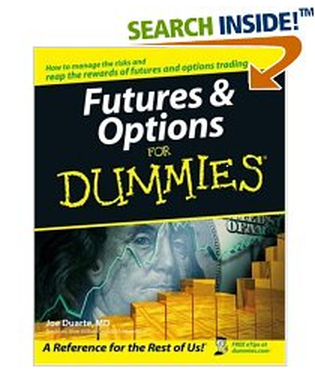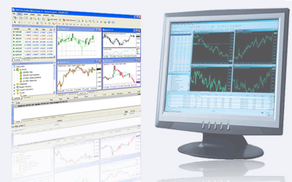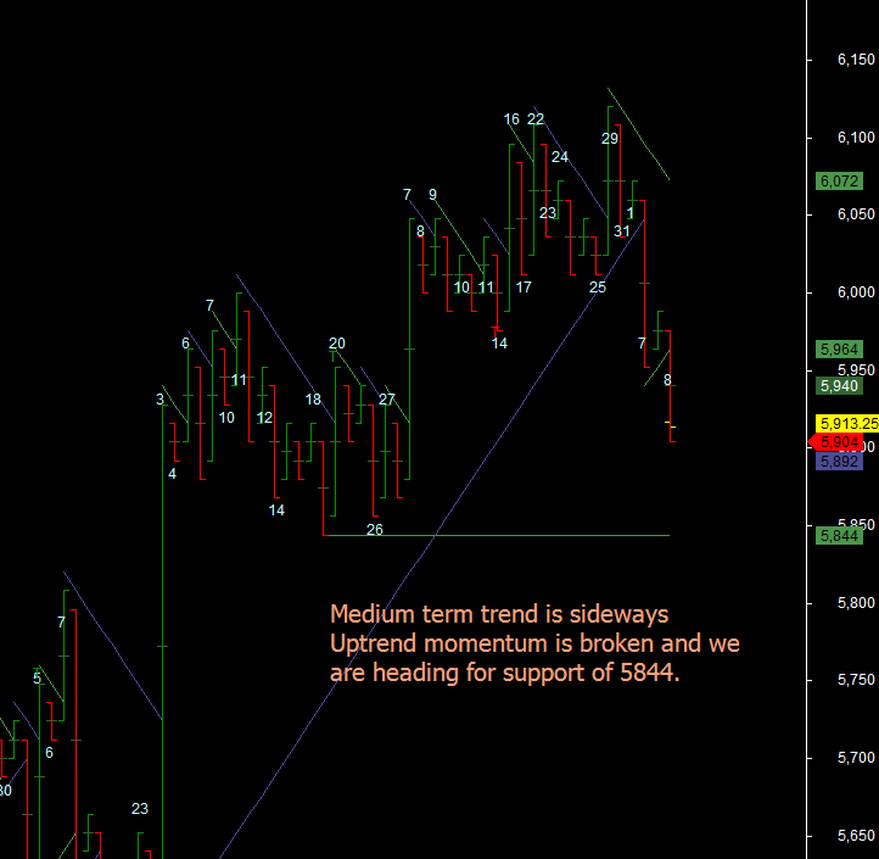| TradeWithMe |
1. Guidance on whether you should you trade or not?

Trading is like any other professional activity that you may choose to do. There is a framework that you need to develop, use and continuously improve and make it profitable and worthwhile to consider as an alternative to any other profession. See the webinar in section 2, as to why you need to treat trading as a business! Without that, do not proceed further.
Various sections in the website, help you to develop this framework. What we say further here in this section is applicable to all market instruments even though their characteristics are different, but are basically tradable in their appropriate markets.
Once you have decided, that you will run trading as a business, we discuss this in two parts, whether you should trade futures and whether you should trade based on the trades of TradeWithMe or others or on your own.
Trading in Futures and Options involves risking your capital and, therefore, you should be aware of the consequences of trading with them. Once you are fully aware of the factors involved in trading these instruments, then you can work on building your trading strategy. This website helps you with most of the aspects that are related to trading.
Various sections in the website, help you to develop this framework. What we say further here in this section is applicable to all market instruments even though their characteristics are different, but are basically tradable in their appropriate markets.
Once you have decided, that you will run trading as a business, we discuss this in two parts, whether you should trade futures and whether you should trade based on the trades of TradeWithMe or others or on your own.
Trading in Futures and Options involves risking your capital and, therefore, you should be aware of the consequences of trading with them. Once you are fully aware of the factors involved in trading these instruments, then you can work on building your trading strategy. This website helps you with most of the aspects that are related to trading.
2. Trading is a Business

Treat trading like a business with an entrepreneural mindset and NOT an opportunistic activity to make money.
Its a business which requires a business plan, operating procedures, different roles that you will perform while trading all of which are important and you need to be aware of these.
Thus for example, before you start trading you are the venture capitalist or investor.
Would you give your money to me or to anyone else with the hope of getting 10% return just like that?
Of course not?
You would want to see a strategy and business plan with a track record?
So when you start trading, you are an entrepreneur and taking all of these roles yourself. However, there is no one to question or evaluate what your are doing. That can be a big risk, if you are not careful.
Ok, so you make your business plan, saying that you have an objective of getting a 10% return on your investment per month by day trading, for example. You break this down to the profit that you would like to target everyday and the loss/risk parameters you will accept.
You write down your operating proocedures after choosing a trading system, whether your own or an advisory service.
You would then take the role of the floor manager, supervisor and worker all rolled into one as a trader. Think about the pre-requisites to carry out these roles and whether you have the skills for them?
If not, step back and learn or prepare yourself for these skills. There is no short cut to become proficient in any real world role. You cant drive a car or a scooter, unless you go through a structured learning process. The same applies to your trading. While TradeWithMe is not specifically addressing this step at this time, we are working on making this happen very soon and we will test it with new customers.
Now you are trading. Do you have a self evaluation process that tells you how well you are tracking your trading system and managing your risks?
If not, please think about this carefully.
At the end of the month, has your bank balance increased or decreased? If not, why not?
90% of the traders who trade on their own or an advisory service will fail, if they do not address these issues.
If you do not make your business plan around trading, you are doomed to failure. See this excellent webinar by Brian McAboy, click here.
However, you have come to the right place with TradeWithMe. We will help you set up your business planning framework, before you start trading.
Its a business which requires a business plan, operating procedures, different roles that you will perform while trading all of which are important and you need to be aware of these.
Thus for example, before you start trading you are the venture capitalist or investor.
Would you give your money to me or to anyone else with the hope of getting 10% return just like that?
Of course not?
You would want to see a strategy and business plan with a track record?
So when you start trading, you are an entrepreneur and taking all of these roles yourself. However, there is no one to question or evaluate what your are doing. That can be a big risk, if you are not careful.
Ok, so you make your business plan, saying that you have an objective of getting a 10% return on your investment per month by day trading, for example. You break this down to the profit that you would like to target everyday and the loss/risk parameters you will accept.
You write down your operating proocedures after choosing a trading system, whether your own or an advisory service.
You would then take the role of the floor manager, supervisor and worker all rolled into one as a trader. Think about the pre-requisites to carry out these roles and whether you have the skills for them?
If not, step back and learn or prepare yourself for these skills. There is no short cut to become proficient in any real world role. You cant drive a car or a scooter, unless you go through a structured learning process. The same applies to your trading. While TradeWithMe is not specifically addressing this step at this time, we are working on making this happen very soon and we will test it with new customers.
Now you are trading. Do you have a self evaluation process that tells you how well you are tracking your trading system and managing your risks?
If not, please think about this carefully.
At the end of the month, has your bank balance increased or decreased? If not, why not?
90% of the traders who trade on their own or an advisory service will fail, if they do not address these issues.
If you do not make your business plan around trading, you are doomed to failure. See this excellent webinar by Brian McAboy, click here.
However, you have come to the right place with TradeWithMe. We will help you set up your business planning framework, before you start trading.
3. Understanding trading Futures and options:

Futures and options trading are leveraged trading instruments, where you take the risk of the gain or loss of the instrument of a particular lot size, by investing a portion of the actual capital needed for the trade.
If you were trading 100 shares of SBI, each share valued at Rs 2,000, you would need Rs 200,000 capital to trade these shares. If the price goes up or down by Rs 10, you gain or lose Rs 20000. However, these gains or losses are notional and do not affect you, so long as you dont actually sell these shares. Which means, even if there are volatile upheavals in the market and the price of SBI goes up and down Rs 2-300, so long as you dont need to withdraw capital, the shares remain in your demat account and the value changes there as part of your investment portfolio along with other shares that you may have.
In the case of futures and options, the situation is very different. One lot of Nifty futures is 50 units (or shares) and if the price is Rs 5000, the value of the lot is 50 x 5000 = Rs 250,000. However, you are required to have only about Rs 20-25000 in your trading account with your broker to trade Nifty futures. This means that you have a leverage of 10:1 on your capital. Now, if the Nifty futures move up or down 50 points, you gain or lose 50 x 50 = Rs 2500 per lot of Nifty futures that you trade, making or losing 10% on your invested capital. This net gain or loss is credited or debited from your trading account. Thus, if you gained, your capital at the end of the day will be Rs 25000+2500 = Rs 27500 (less brokerage and taxes, usually around Rs 150 per lot for a full trade consisting of a buy and sell or sell and buy).
Note the important consequence of this trade. If you lost money, you have Rs 22,500 at the start of the next trading day. Lets say, Rs 20000 is the minimum margin money needed in your account to trade Nifty Futures. Lets also say, that you lose another 50 points today. The consequence is that the next day, you will not have enough capital to trade at all. This is different from the holding of shares, where only the value of your investment has come down. You can still sell your 100 shares of SBI at the lower price, say of Rs 1900, and buy back the shares at a lower price or at a higher price based on the money that yoy have. In the case, of futures, the lot size is the minimum that you can trade Nifty futures. You cannot trade 30 units, as the minimum is 50 units per lot. (unless you switch to mini-Nifty which is just 20 units).
Note the other important point. That with capital or margin of Rs 25000 originally, you are taking a risk related to the full investment of Rs 250000 for one lot of Nifty futures and all the gains or losses related to that. With each rupee of your holding of 100 shares, your shares portfolio increases or decreases by Rs 100, but you still have 100 physical shares of SBI. With futures contracts, the value can change to such an extent, that all your capital could get wiped out. For example, a move of 500 points, which can happen in about 10 days is all it takes to reduce Rs 25000 to zero if you did nothing in a downtrending market. That will never happen with your 100 SBI shares.
In Futures contracts, the value of your capital account is adjusted daily to match the changes in the Nifty Futures value from the open of the day. This has possible consequences of giving unlimited gains or unlimited losses to you.
Options are the second set of instruments which are leveraged instruments where the leverage is even higher. For example at the start of an expiry period of a futures series, options contracts for in the money options for Nifty are in the region of Rs 120 per lot of 50 units or a value of around Rs 6000 for the same Nifty lot of Rs 250000. However, there is an important difference, that your total risk is your invested value or Rs 6000, nothing more or less.
In the case of options, lets say you bought them in the beginning of April and you did nothing till the expiry. If your strike price was 5000 and the spot value of Nifty closed at 4900 on expiry, your options are worthless and you lose the complete Rs 6000. If the spot value is 5010 on expiry day,you make Rs 10 x 50 = Rs 500, but you still lose the Rs 6000 that you invested or a net loss of Rs 5500. Why is this? Thats because options have a time value associated with them. Thus if the 5000 series call options were bought at Rs 120 this represents a premium charged by the option writer who sold it to you and it represents a time value. The time value reduces continuously on a proportionate basis everyday. This gets masked by the changes in the spot value and market volatility, which affect the option contracts value at any time. As a general rule, unless you are using options to hedge the value of your investments, they should not be held for more than 2-3 days for a trade, as the loss in time value becomes difficult to cover.
Another aspect of options is that if the spot move 10 points, the futures will also move 10 points or nearly so, but options will move 0.1-1.0 or Delta times this movement, depending on how far out of money the option series is from the spot value or in the money. Thus if spot value is 5000. A 4800 CALL option will have a Delta of 0.99 or so. If the CALL option is a 5200 series, the delta value will be about 0.8-0.7 and for a 5600 CALL option it will be around 0.2 or so. The same applies in reverse for the PUT options.
The consequence of this is that when you trade options, in the money options gives the most gains or losses while out of the money options give lower gains or losses. In the case of a 5200 CALL say priced at Rs 80 and a Delta of 0.8, the investment is Rs 4000 and the Nifty moves up 50 points. The gain will be 50x50x0.8 = Rs 2000 versus the Rs 2500 for the futures. But look at your RoI.. Rs 2000 on an investment of Rs 4000 = 50% gain vs Rs 2500 on a margin investment of Rs 25000 = 10%. In the same way if Nifty moves 50 points down, 50% of your capital gets wiped out! with disastrous consequences.
So both futures and options have high risk and can lead to your capital being wiped out, in case you dont manage risk.
Should you trade futures and options in that case?
The answer is you should understand the above mechanics carefully and all the hidden costs in your trades and make sure you have a sound risk and money management system in place. If you dont, you and your money wont be friends for long!!
If you were trading 100 shares of SBI, each share valued at Rs 2,000, you would need Rs 200,000 capital to trade these shares. If the price goes up or down by Rs 10, you gain or lose Rs 20000. However, these gains or losses are notional and do not affect you, so long as you dont actually sell these shares. Which means, even if there are volatile upheavals in the market and the price of SBI goes up and down Rs 2-300, so long as you dont need to withdraw capital, the shares remain in your demat account and the value changes there as part of your investment portfolio along with other shares that you may have.
In the case of futures and options, the situation is very different. One lot of Nifty futures is 50 units (or shares) and if the price is Rs 5000, the value of the lot is 50 x 5000 = Rs 250,000. However, you are required to have only about Rs 20-25000 in your trading account with your broker to trade Nifty futures. This means that you have a leverage of 10:1 on your capital. Now, if the Nifty futures move up or down 50 points, you gain or lose 50 x 50 = Rs 2500 per lot of Nifty futures that you trade, making or losing 10% on your invested capital. This net gain or loss is credited or debited from your trading account. Thus, if you gained, your capital at the end of the day will be Rs 25000+2500 = Rs 27500 (less brokerage and taxes, usually around Rs 150 per lot for a full trade consisting of a buy and sell or sell and buy).
Note the important consequence of this trade. If you lost money, you have Rs 22,500 at the start of the next trading day. Lets say, Rs 20000 is the minimum margin money needed in your account to trade Nifty Futures. Lets also say, that you lose another 50 points today. The consequence is that the next day, you will not have enough capital to trade at all. This is different from the holding of shares, where only the value of your investment has come down. You can still sell your 100 shares of SBI at the lower price, say of Rs 1900, and buy back the shares at a lower price or at a higher price based on the money that yoy have. In the case, of futures, the lot size is the minimum that you can trade Nifty futures. You cannot trade 30 units, as the minimum is 50 units per lot. (unless you switch to mini-Nifty which is just 20 units).
Note the other important point. That with capital or margin of Rs 25000 originally, you are taking a risk related to the full investment of Rs 250000 for one lot of Nifty futures and all the gains or losses related to that. With each rupee of your holding of 100 shares, your shares portfolio increases or decreases by Rs 100, but you still have 100 physical shares of SBI. With futures contracts, the value can change to such an extent, that all your capital could get wiped out. For example, a move of 500 points, which can happen in about 10 days is all it takes to reduce Rs 25000 to zero if you did nothing in a downtrending market. That will never happen with your 100 SBI shares.
In Futures contracts, the value of your capital account is adjusted daily to match the changes in the Nifty Futures value from the open of the day. This has possible consequences of giving unlimited gains or unlimited losses to you.
Options are the second set of instruments which are leveraged instruments where the leverage is even higher. For example at the start of an expiry period of a futures series, options contracts for in the money options for Nifty are in the region of Rs 120 per lot of 50 units or a value of around Rs 6000 for the same Nifty lot of Rs 250000. However, there is an important difference, that your total risk is your invested value or Rs 6000, nothing more or less.
In the case of options, lets say you bought them in the beginning of April and you did nothing till the expiry. If your strike price was 5000 and the spot value of Nifty closed at 4900 on expiry, your options are worthless and you lose the complete Rs 6000. If the spot value is 5010 on expiry day,you make Rs 10 x 50 = Rs 500, but you still lose the Rs 6000 that you invested or a net loss of Rs 5500. Why is this? Thats because options have a time value associated with them. Thus if the 5000 series call options were bought at Rs 120 this represents a premium charged by the option writer who sold it to you and it represents a time value. The time value reduces continuously on a proportionate basis everyday. This gets masked by the changes in the spot value and market volatility, which affect the option contracts value at any time. As a general rule, unless you are using options to hedge the value of your investments, they should not be held for more than 2-3 days for a trade, as the loss in time value becomes difficult to cover.
Another aspect of options is that if the spot move 10 points, the futures will also move 10 points or nearly so, but options will move 0.1-1.0 or Delta times this movement, depending on how far out of money the option series is from the spot value or in the money. Thus if spot value is 5000. A 4800 CALL option will have a Delta of 0.99 or so. If the CALL option is a 5200 series, the delta value will be about 0.8-0.7 and for a 5600 CALL option it will be around 0.2 or so. The same applies in reverse for the PUT options.
The consequence of this is that when you trade options, in the money options gives the most gains or losses while out of the money options give lower gains or losses. In the case of a 5200 CALL say priced at Rs 80 and a Delta of 0.8, the investment is Rs 4000 and the Nifty moves up 50 points. The gain will be 50x50x0.8 = Rs 2000 versus the Rs 2500 for the futures. But look at your RoI.. Rs 2000 on an investment of Rs 4000 = 50% gain vs Rs 2500 on a margin investment of Rs 25000 = 10%. In the same way if Nifty moves 50 points down, 50% of your capital gets wiped out! with disastrous consequences.
So both futures and options have high risk and can lead to your capital being wiped out, in case you dont manage risk.
Should you trade futures and options in that case?
The answer is you should understand the above mechanics carefully and all the hidden costs in your trades and make sure you have a sound risk and money management system in place. If you dont, you and your money wont be friends for long!!
4. Trading on your own

Most of the points in the next section also apply to trading on your own. Develop your trading system and then read the reference given here.
For more details, you should read the section : http://www.tradewithme.me/build-your-trading-strategy.html
For more details, you should read the section : http://www.tradewithme.me/build-your-trading-strategy.html
5. Working with a subscriptions based advisory ?

In looking to work with a subscriptions service that offers you trading advice or even on your own, you should be clear that the trading service is offering it services in consideration for a subscription that you pay. All risks and rewards of the advice that you may follow from them (or your own methods) are to your account only. As they are only giving advice and do not track whether you trade as per their advice or not.
So its your money that pays for the subscription and its your decision to trade with that advisory that affects your gains or losses. However, the factors that affect your ability to follow an advisory service are as follows, which you should carefully consider:
- Does the service have a track record that is published and available.
- Do they indicate what you may earn with the profile of your trading? (one lot, two lots etc).
- How are their calls given? Is it possible to practically execute the trades advised in the time available?
- Do they give clear targets and exit rules including stop losses?
- Can you discontinue the service and get a refund if needed?
More importantly, you should also evaluate that you will be able to work with an advisory service.When working with an advisory, you are doing dumb trading or simply tracking the trades they are advising. Here are the important personality traits (which apply even to your own trading method) you should have:
- Can you execute trades in a reasonable time once you get a message? Usually this should take no more than 15-20 seconds.
- Are you able to exit and lock in the profits once the targets are achieved?
- Do you understand that the liability and consequence of following an advisory is all yours? There is no way the advisory will know what you are really doing.
- Assuming that the trades indicated by the advisory are profitable, and you still make a loss, what could go wrong? It could be that you dont enter the trade at the level advised. You exit before a target is reached. Or you entered your own trade which was different from what was suggested. All these are NO NO's for a trader. You need to blindly follow all trades of the advisory to get the best benefit.
- However, even if you follow an advisory blindly, you need to make sure that you have your risk management system in place. Read more about that in the Trading strategy section Section 9.4 onwards http://www.tradewithme.me/build-your-trading-strategy.html :
- Test trade the advisory's service for a week before becoming a regular subscriber.
- Do you get emotional about your trades and make mistakes which result in your trades being different than what are advised? If yes, calm yourself down by doing activities like Yoga, meditation, jogging/regular exercise or look for a mentor.
If you still feel comfortable and confident on managing your trading activities as indicated above, go ahead and test your trading skills with us or on your own or with anyone else. Good luck on your journey. And if you get stuck, ever, even if you dont trade with us, write, and we will help you (click here).
So its your money that pays for the subscription and its your decision to trade with that advisory that affects your gains or losses. However, the factors that affect your ability to follow an advisory service are as follows, which you should carefully consider:
- Does the service have a track record that is published and available.
- Do they indicate what you may earn with the profile of your trading? (one lot, two lots etc).
- How are their calls given? Is it possible to practically execute the trades advised in the time available?
- Do they give clear targets and exit rules including stop losses?
- Can you discontinue the service and get a refund if needed?
More importantly, you should also evaluate that you will be able to work with an advisory service.When working with an advisory, you are doing dumb trading or simply tracking the trades they are advising. Here are the important personality traits (which apply even to your own trading method) you should have:
- Can you execute trades in a reasonable time once you get a message? Usually this should take no more than 15-20 seconds.
- Are you able to exit and lock in the profits once the targets are achieved?
- Do you understand that the liability and consequence of following an advisory is all yours? There is no way the advisory will know what you are really doing.
- Assuming that the trades indicated by the advisory are profitable, and you still make a loss, what could go wrong? It could be that you dont enter the trade at the level advised. You exit before a target is reached. Or you entered your own trade which was different from what was suggested. All these are NO NO's for a trader. You need to blindly follow all trades of the advisory to get the best benefit.
- However, even if you follow an advisory blindly, you need to make sure that you have your risk management system in place. Read more about that in the Trading strategy section Section 9.4 onwards http://www.tradewithme.me/build-your-trading-strategy.html :
- Test trade the advisory's service for a week before becoming a regular subscriber.
- Do you get emotional about your trades and make mistakes which result in your trades being different than what are advised? If yes, calm yourself down by doing activities like Yoga, meditation, jogging/regular exercise or look for a mentor.
If you still feel comfortable and confident on managing your trading activities as indicated above, go ahead and test your trading skills with us or on your own or with anyone else. Good luck on your journey. And if you get stuck, ever, even if you dont trade with us, write, and we will help you (click here).
6 Why do traders fail?

90%+ traders fail to make money. And the reason for that is primarily the following:
- Lack of a clear vision or objective and a plan that puts into action.
- Throwing the plan to the winds during actual trading and trading in an indisciplined manner.
- Not having a sound risk and money management system.
- Never reviewing their trading activities.
Do not fall into this trap - make your objectives come true with mentored and coached trading support. Get in touch with us now! (click here).
- Lack of a clear vision or objective and a plan that puts into action.
- Throwing the plan to the winds during actual trading and trading in an indisciplined manner.
- Not having a sound risk and money management system.
- Never reviewing their trading activities.
Do not fall into this trap - make your objectives come true with mentored and coached trading support. Get in touch with us now! (click here).
If you've read this, dont forget to read "Intraday or Positional? (click here)
|
Want more information ? Get in touch with us through the contact form : (click here)
|
|